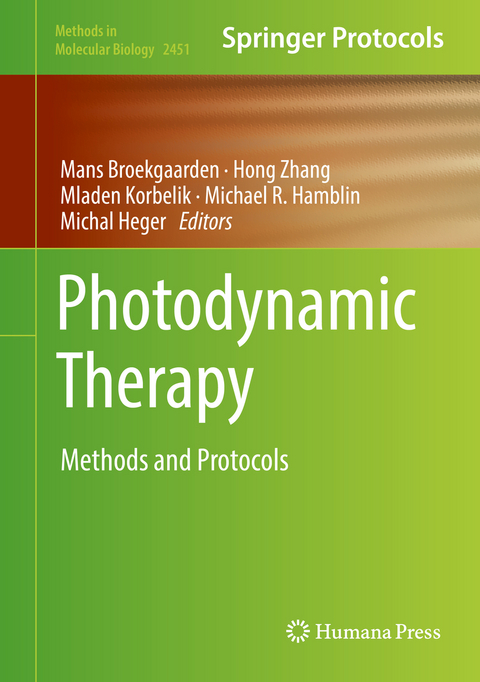
Photodynamic Therapy
Springer-Verlag New York Inc.
978-1-0716-2098-4 (ISBN)
Thorough and authoritative, Photodynamic Therapy: Methods and Protocols serves as an ideal source of inspiration for both new and established PDT scientists and a guide for designing innovative research programs in this continuously advancing and multidisciplinary field.
Application of Monolayer Cell Cultures for Investigating Basic Mechanisms of Photodynamic Therapy.- The Negative Impact of Cancer Cell Nitric Oxide on Photodynamic Therapy.- Microtumor Models as a Preclinical Investigational Platform for Photodynamic Therapy.- A Microfluidic Model to Evaluate Photodynamic Therapy Treatment Response in 3D Tumors.- Analysis of Treatment Effects on Structurally Complex Microtumor Cultures Using a Comprehensive Image Analysis Procedure.- High-Throughput Examination of Therapy-Induced Alterations in Redox Metabolism in Spheroid and Microtumor Models.- Spatiotemporal Tracking of Different Cell Populations in Cancer Organoid Models for Investigations on Photodynamic Therapy.- Generating Large Numbers of Pancreatic Microtumors on Alginate-Gelatin Hydrogels for Quantitative Imaging of Tumor Growth and Photodynamic Therapy Optimization.- The Chicken Embryo Chorioallantoic Membrane as an In Vivo Model for Photodynamic Therapy.- Subcutaneous Xenograft Models for Studying PDT In Vivo.- In Vivo Models for Studying Interstitial Photodynamic Therapy of Locally Advanced Cancer.- Orthotopic Models of Pancreatic Cancer to Study PDT.- An Orthotopic Murine Model of Peritoneal Carcinomatosis of Ovarian Origin for Intraoperative PDT.- Photodynamic Treatments for Disseminated Cancer Metastases Using Fiber-Optic Technologies.- Stereotaxic Implantation of F98 Cells in Fischer Rats: A Syngeneic Model to Investigate Photodynamic Therapy Response in Glioma.- New Generation of Photosensitizers Based on Inorganic Nanomaterials.- Cytotoxicity of Metal-Based Photoactivated Chemotherapy (PACT) Compounds.- Photosensitized Oxidation of Intracellular Targets: Understanding the Mechanisms to Improve the Efficiency of Photodynamic Therapy.- Inhibition of the HIF-1 Survival Pathway as a Strategy to Augment Photodynamic Therapy Efficacy.- Strategies for Improving Photodynamic Therapy through Pharmacological Modulation of the Immediate Early Stress Response.- Nanobody-Targeted Photodynamic Therapy: Nanobody Production and Purification.- Conjugation of IRDye Photosensitizers or Fluorophores to Nanobodies.- In Vitro Assessment of Binding Affinity, Selectivity, Uptake, Intracellular Degradation, and Toxicity of Nanobody-Photosensitizer Conjugates.- Assessment of the In Vivo Response to Nanobody-Targeted PDT through Intravital Microscopy.- Orthotopic Breast Cancer Model to Investigate the Therapeutic Efficacy of Nanobody-Targeted Photodynamic Therapy.- Investigation of the Therapeutic Potential of Nanobody-Targeted Photodynamic Therapy in an Orthotopic Head and Neck Cancer Model.- Evaluation of the Antitumor Immune Response Following Photofrin-Based PDT in Combination with the Epigenetic Agent 5-Aza-2’-Deoxycytidine.- Controlling Immunoregulatory Cell Activity for Effective Photodynamic Therapy of Cancer.- Measuring the Anti-Tumor T-Cell Response in the Context of Photodynamic Therapy.- Combination of Photodynamic Therapy and Immune Checkpoint Blockade.- Combination of Photodynamic Therapy and Therapeutic Vaccination.- In Vitro Potentiation of Antimicrobial Photodynamic Inactivation by Addition of Potassium Iodide.- In Vivo Potentiation of Antimicrobial Photodynamic Therapy in a Mouse Model of Fungal Infection by Addition of Potassium Iodide.- Bioluminescent Models to Evaluate the Efficiency of Light-Based Antibacterial Approaches.- Photochemical Internalization as a New Strategy to Enhance Efficacy of Antimicrobial Agents against Intracellular Infections.- Determination of the Efficiency of Photodynamic Decontamination of Food.- Super-Resolution Imaging of Intracellular Lipid Nanocarriers to Study Drug Delivery in Photodynamic Therapy.- Detection of Paraptosis after Photodynamic Therapy.- Optimal Use of 2´,7´-Dichlorofluorescein Diacetate in Cultured Hepatocytes.
| Erscheinungsdatum | 09.05.2022 |
|---|---|
| Reihe/Serie | Methods in Molecular Biology ; 2451 |
| Zusatzinfo | 114 Illustrations, color; 28 Illustrations, black and white; XVI, 752 p. 142 illus., 114 illus. in color. |
| Verlagsort | New York, NY |
| Sprache | englisch |
| Maße | 178 x 254 mm |
| Themenwelt | Medizin / Pharmazie ► Medizinische Fachgebiete ► Psychiatrie / Psychotherapie |
| Studium ► Querschnittsbereiche ► Infektiologie / Immunologie | |
| ISBN-10 | 1-0716-2098-3 / 1071620983 |
| ISBN-13 | 978-1-0716-2098-4 / 9781071620984 |
| Zustand | Neuware |
| Informationen gemäß Produktsicherheitsverordnung (GPSR) | |
| Haben Sie eine Frage zum Produkt? |
aus dem Bereich


